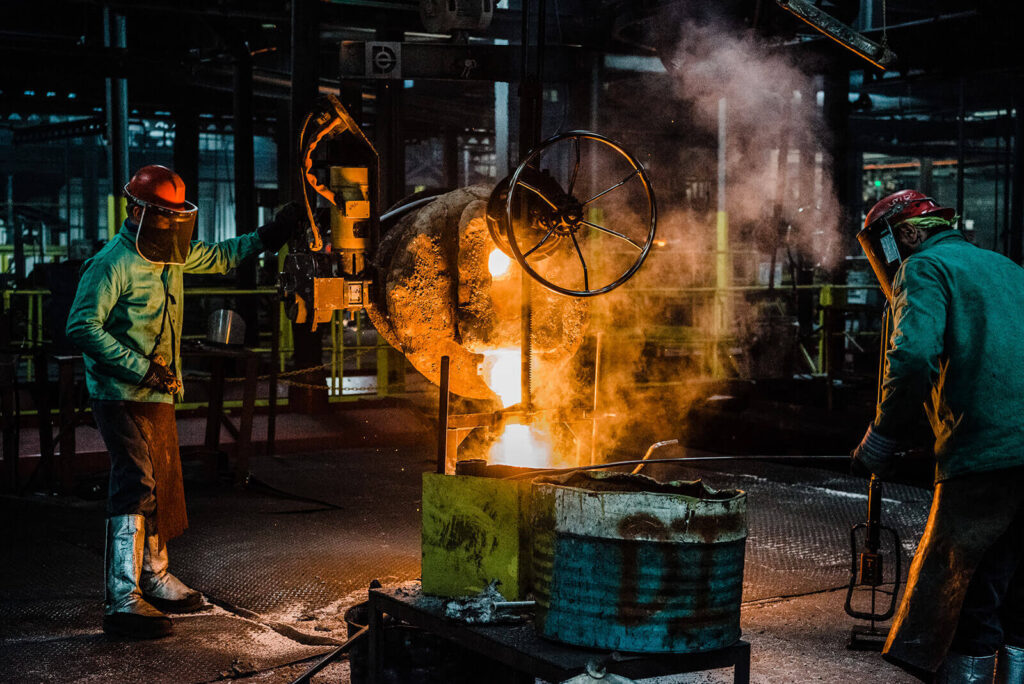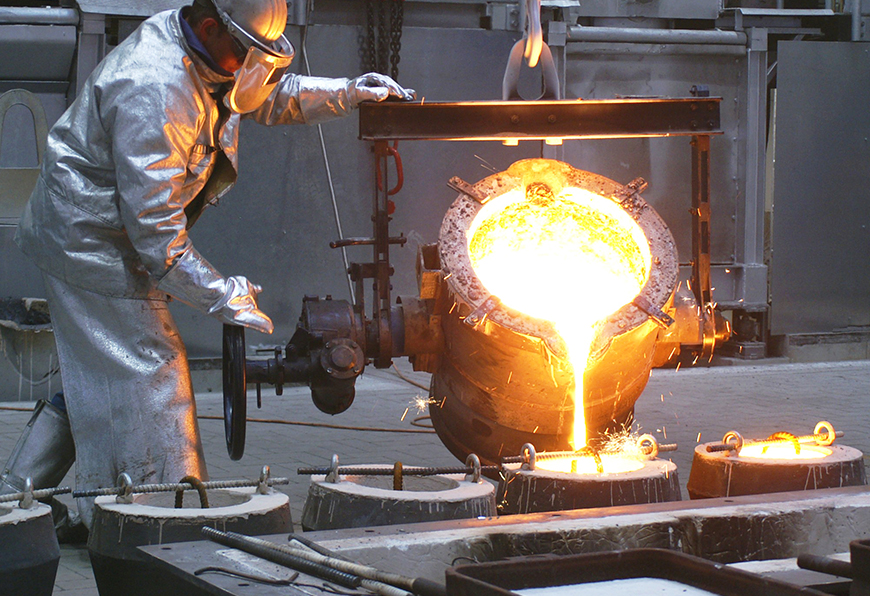Aluminum Foundry and renewable energy: Solar-powered casting
All Regarding Aluminum Foundry: Secret Makes Use Of and Its Effect On Product Growth
Aluminum foundries are necessary in modern-day manufacturing, specifically in industries like automotive and aerospace. They make use of advanced techniques to produce light-weight, resilient elements that boost efficiency. The versatility of aluminum likewise straightens with sustainability campaigns, making it a recommended material. Nevertheless, the recurring developments in casting methods and their implications for item advancement raise important inquiries. What future developments might reshape the landscape of aluminum foundries and their applications?
Summary of Aluminum Foundries
Aluminum foundries function as crucial facilities in the metalworking industry, focusing on the casting of aluminum and its alloys. These facilities use various techniques, including sand casting, die casting, and investment casting, to change raw aluminum right into functional types. Each casting method offers special advantages, satisfying various task demands ranging from little elements to big architectural aspects.
The foundries operate via a careful process that begins with melting aluminum, followed by putting the molten steel right into molds. After cooling, the castings undertake completing processes, which might include machining and surface therapy to meet specific requirements.
Quality control is critical, making sure that the end products fulfill industry criteria and consumer assumptions. In addition, aluminum foundries typically emphasize sustainability by recycling scrap aluminum, consequently decreasing waste and saving sources. This commitment to reliable production and environmental responsibility settings aluminum foundries as essential contributors to the production landscape.

Secret Applications of Aluminum Castings
Aluminum castings serve essential duties in numerous markets, especially in automotive and aerospace industries. In the automobile industry, they add to light-weight structures and effective efficiency. Aerospace element production depends on aluminum castings for their stamina and deterioration resistance, vital for high-performance applications.
Automotive Industry Applications
In the automotive sector, aluminum castings play a crucial function in enhancing automobile performance and efficiency. These castings are widely used for elements such as engine blocks, transmission housings, and suspension components. Their lightweight nature adds to lowered vehicle weight, which subsequently boosts fuel economic situation and handling. Additionally, aluminum's outstanding thermal conductivity enables effective heat dissipation, necessary for high-performance engines. The corrosion resistance of aluminum likewise extends the life-span of vehicle parts, decreasing upkeep costs. In addition, improvements in casting modern technologies allow the manufacturing of complex forms, maximizing the design and functionality of components. On the whole, aluminum castings are essential to modern-day auto design, supporting advancement and sustainability in vehicle design.
Aerospace Element Manufacturing
The aerospace industry significantly counts on aluminum castings for a variety of essential components because of their advantageous properties. Lightweight yet strong, aluminum castings improve gas efficiency and total performance in airplane layout. Parts such as engine places, structural frames, and landing gear are typically generated using aluminum casting strategies, allowing suppliers to achieve complicated geometries while maintaining architectural integrity. The high resistance to corrosion and thermal properties of aluminum also add to the durability and dependability of aerospace parts. Additionally, advancements in casting technologies, such as precision casting and 3D printing, have actually broadened the abilities of aluminum in this market. Eventually, aluminum castings play an important role in conference rigorous safety and security requirements and efficiency demands in contemporary aerospace applications.
Advantages of Using Aluminum in Production
While countless products are readily available for production, aluminum sticks out because of its distinct combination of properties that boost effectiveness and performance. One substantial benefit of aluminum is its lightweight nature, which contributes to decreased power consumption and enhanced gas efficiency in various applications. Additionally, aluminum shows excellent corrosion resistance, prolonging the life expectancy of products and decreasing maintenance costs. Its high thermal and electric conductivity makes it appropriate for warm exchangers and electric elements, while its pliability allows for versatile layouts and complex forms.
Moreover, aluminum is recyclable, promoting sustainability in producing processes. This reusability not only preserves sources yet also lowers the carbon impact connected with manufacturing. The flexibility of aluminum to different alloys further enhances its energy in varied industries, from automobile to customer electronics. Jointly, these features make aluminum an optimal selection for makers seeking to balance efficiency, cost-effectiveness, and ecological responsibility.
Innovations in Casting Strategies
Current improvements in casting strategies have significantly changed the aluminum factory industry. The combination of 3D printing innovation has allowed a lot more intricate layouts, while boosted alloy solutions enhance efficiency and sturdiness. These technologies are driving performance and increasing the applications of aluminum in various industries.
3D Printing Combination

Improved Alloy Formulas
Innovations in aluminum foundry technology have actually brought about the growth of enhanced alloy formulations that improve casting efficiency and product properties. These cutting-edge formulations often integrate components check such as silicon, magnesium, and copper, which enhance strength, ductility, and corrosion resistance. By fine-tuning the compositions, producers can achieve certain features customized to varied applications, from vehicle to aerospace sectors. Furthermore, these improved alloys promote far better fluidness throughout the casting process, minimizing issues and boosting surface area finish. Consequently, the efficiency of manufacturing is considerably raised while keeping rigid quality criteria. This advancement in alloy development not only improves manufacturing however also sustains the development of lighter, more powerful parts, eventually progressing item advancement and performance.
Impact on Aerospace and Automotive Industries
The significant impact of aluminum foundries on the aerospace and automobile industries can not be overemphasized. Aluminum alloys, understood for their lightweight and high toughness, have transformed the style and production processes in both markets. In aerospace, the decrease in weight straight correlates to sustain effectiveness, permitting longer flights and reduced discharges. Components such as airplane frames, wings, and engine components gain from aluminum's outstanding tiredness resistance and deterioration resistance.
In the vehicle market, aluminum foundries add to the production of lighter automobiles, boosting efficiency and fuel economic situation while satisfying strict environmental laws. The use of aluminum in engine blocks, body panels, and wheels has actually boosted significantly, driven by consumer demand for extra reliable lorries. Furthermore, innovations in casting strategies have improved the accuracy and capability of components, enabling makers to establish even more integrated and complex styles, thus fostering innovations in both industries.
Sustainability Practices in Aluminum Foundries
Aluminum foundries are significantly accepting sustainability practices to lower their ecological footprint while meeting the expanding needs of the aerospace and auto industries. These over at this website techniques include the application of energy-efficient innovations, such as electrical melting heating systems and advanced heat recuperation systems, which greatly lower energy intake (Aluminum Foundry). Furthermore, numerous foundries are focusing on using recycled aluminum, which calls for much less energy and leads to lowered greenhouse gas exhausts contrasted to main aluminum manufacturing
Water conservation campaigns are also obtaining grip, with foundries utilizing closed-loop systems to lessen water usage and avoid contamination. Additionally, waste monitoring methods, including reusing scrap and decreasing contaminated materials, add to a much more lasting procedure. By embracing these techniques, aluminum foundries not only boost their competitiveness but additionally straighten with global sustainability goals, this page inevitably sustaining a round economic situation and promoting advancement in eco-friendly production processes.
Future Trends in Aluminum Spreading Innovation
As the demand for lightweight and long lasting products remains to climb, advancements in casting innovation are poised to improve the aluminum sector. Advanced methods such as 3D printing and automated casting processes are getting grip, permitting a lot more complicated geometries and minimized material waste. The assimilation of synthetic intelligence and maker learning is also improving quality assurance and procedure optimization, decreasing defects and enhancing efficiency.
Furthermore, the growth of new aluminum alloys is increasing the application range of actors products, making them ideal for markets from automotive to aerospace. Boosted recycling techniques are anticipated to further reduce ecological influences, aligning with international sustainability goals.
Additionally, making use of smart sensing units in casting processes is anticipated to allow real-time surveillance, making certain better accuracy and uniformity. These fads represent a transformative age in aluminum casting technology, enabling makers to fulfill advancing market demands while prioritizing sustainability and advancement.
Frequently Asked Inquiries
Exactly How Is Aluminum Recycled After Usage in Products?
Aluminum reusing entails collecting, sorting, and melting made use of aluminum products (Aluminum Foundry). The liquified steel is after that cast into brand-new forms, minimizing power consumption and maintaining natural deposits, making it a reliable and lasting process for aluminum recuperation
What Precaution Are Applied in Aluminum Foundries?
Safety procedures in aluminum foundries include correct air flow systems, individual safety equipment, normal safety and security training, tools upkeep protocols, and emergency response plans, all intended at reducing dangers related to high temperature levels and hazardous materials during production.
Just How Do Aluminum Foundries Make Certain High Quality Control?
Aluminum foundries execute extensive quality assurance processes, including material examinations, temperature surveillance, and dimensional checks. These steps guarantee item consistency, lower defects, and follow sector standards, eventually boosting consumer fulfillment and operational efficiency.
What Prevail Difficulties Dealt With by Aluminum Foundries?
Aluminum foundries typically encounter obstacles such as keeping regular high quality, handling manufacturing costs, making sure prompt delivery, dealing with equipment upkeep, and adapting to progressing market laws. These aspects can greatly affect general operational efficiency and success.
Just How Does Aluminum Spreading Affect Product Weight?
Aluminum casting considerably decreases item weight as a result of aluminum's reduced thickness contrasted to other steels - Aluminum Foundry. This lightweight particular boosts design adaptability, boosts gas performance in transport applications, and provides advantages in various markets calling for weight-sensitive components